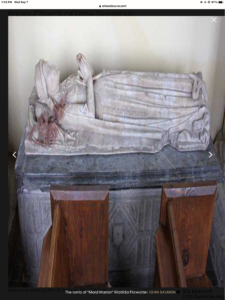How many remember programs/movies about RobinHood? Do you remember the main female character, Maid Marian? The question is; did she exist? The answer comes to us from..

The Tomb of Maid Marian
Priory Church of Little Dunmow
Little Dunmow, England
It’s believed Matilda Fitzwalter’s life was the basis for the famed literary figure.
THE PRIORY CHURCH OF LITTLE Dunmow, St Mary the Virgin, one of Essex’s oldest buildings, stands a short distance from the Flitch Way, a nature walk named after the Flitch Trial.

St Mary’s Church was originally the lady chapel of a 12th-century Augustinian priory, but is now all that remains. Inside this former chapel lies an alabaster tomb, that depicts one of the most famous women in British history, Maid Marian.

Fabled partner of Robin Hood, the legendary character of Maid Marian was inspired by the life and lore surrounding an Essex baron’s daughter by the name of Matilda Fitzwalter.
Born sometime during the early 12th-century, Fitzwalter was the daughter of Robert, Baron Fitzwalter, the wealthy Lord of Little Dunmow. He was well known for his leadership of the barons that forced King John into signing the Magna Carta.
One possible reason for Robert’s ill feelings towards King John surrounds Matilda’s 18th-birthday, a tale that has now become legendary because it’s the first time she encountered Robin Hood.
It’s said that Matilda’s father hosted a great banquet and tournament for an array of guests. It was on the fourth day however that the festivities truly came to a peak when a knight, familiar to no-one, made small work of each and every opponent in the joust and melee.
Matilda quickly fell for the knight, not long before he disappeared into the night. Just as Matilda had admired the knight, Prince John, the future king, had been admiring Matilda from afar and wanted to take her as a mistress.
Rejected by both the baron and his daughter for the indignity and offensiveness of the desire, John became furious. This event is recorded not only in literature but in historical documents as well, as Baron Fitzwalter was banished during the early 13th-century.
The later events of Matilda’s life are somewhat a melting pot of history and legend. It’s said that she narrowly escaped the prince’s wrath and power. When fleeing her home to hide in the forest, she came upon the mysterious knight once again. At this meeting, however, he was no longer a lonely figure hidden by steel armor, but rather one of a group of merry men dressed as an archer. He introduced himself finally as the one and only outlaw earl, Robin Hood.
Her new acquaintances were not enough to hide Matilda from the prince’s hunt. The story goes that Maid Marian, Matilda herself, met John in battle and forced him to withdraw in shame.
Eventually, King Richard restored Robin Hood’s earldom. Matilda, who had recently married the former outlaw, became the Countess of Huntingdon. This return to peace was short-lived. When King Richard died, the crown went to his brother, the cruel Prince John.
King John outlawed Robin Hood once again, and within only a few years the much-loved people’s hero died, leaving Matilda at risk of the king’s cruelty. Matilda took refuge in Dunmow Priory for protection. But this was not enough to shield her from the king. Under the guise of brokering peace, the king secretly plotted to murder Matilda within her shelter.
John sent a peace envoy to Dunmow, with the gift of a poisoned bracelet. The envoy, a chivalrous knight, was wholly unaware of the plan.
Such a well thought of gentleman, the envoy was allowed an audience with Matilda, allowing him to present her with the deadly gift. Matilda promptly placed the bracelet on her wrist. Within moments, as legend has it, she turned pale. It’s said that the poison was so strong that it burned through her wrist.
Matilda was supposedly laid to rest surrounded by flowers and maintained a graceful smile even in death, an image that remains on the tomb of her final sanctuary.
Thread Image:Olivia de Havilland as Maid Marian in The Adventures of Robin Hood (1938)
